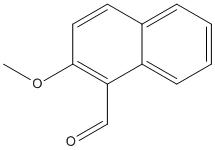2-methoxy-1-naphthaldehyde
XM-47inhibits D14-SLR1 and D14-D53 interactions. Product of XM-47 hydrolysis, 2-methoxy-1-naphthaldehyde (2-MN), inhibits D14-SLR1 and D14-D53 interactions and restores the growth of rice tillering buds suppressed by strigolactone
General
Type : Naphthalen,Strigolactone receptors ligand
Chemical_Nomenclature : 2-methoxynaphthalene-1-carbaldehyde
Canonical SMILES : COC1=C(C2=CC=CC=C2C=C1)C=O
InChI : InChI=1S\/C12H10O2\/c1-14-12-7-6-9-4-2-3-5-10(9)11(12)8-13\/h2-8H,1H3
InChIKey : YIQGLTKAOHRZOL-UHFFFAOYSA-N
Other name(s) : 2-MN,1-Naphthalenecarboxaldehyde, 2-methoxy-,MFCD00004004,SCHEMBL1002660,CHEMBL3265259,ZINC1410772
MW : 186.21
Formula : C12H10O2
CAS_number : 5392-12-1
PubChem : 79352
UniChem : YIQGLTKAOHRZOL-UHFFFAOYSA-N
IUPHAR :
Wikipedia :

Target
Families : 2-methoxy-1-naphthaldehyde ligand of proteins in family: RsbQ-like
Stucture :
Protein : orysj-Q10QA5
References (2)
| Title : Regulation of biosynthesis, perception, and functions of strigolactones for promoting arbuscular mycorrhizal symbiosis and managing root parasitic weeds - Yoneyama_2019_Pest.Manag.Sci_75_2353 |
| Author(s) : Yoneyama K , Xie X , Nomura T , Takahashi I , Asami T , Mori N , Akiyama K , Kusajima M , Nakashita H |
| Ref : Pest Manag Sci , 75 :2353 , 2019 |
| Abstract : Yoneyama_2019_Pest.Manag.Sci_75_2353 |
| ESTHER : Yoneyama_2019_Pest.Manag.Sci_75_2353 |
| PubMedSearch : Yoneyama_2019_Pest.Manag.Sci_75_2353 |
| PubMedID: 30843315 |
| Title : Discovery and identification of 2-methoxy-1-naphthaldehyde as a novel strigolactone-signaling inhibitor - Mashita_2016_J.Pestic.Sci_41_71 |
| Author(s) : Mashita O , Koishihara H , Fukui K , Nakamura H , Asami T |
| Ref : J Pestic Sci , 41 :71 , 2016 |
| Abstract : Mashita_2016_J.Pestic.Sci_41_71 |
| ESTHER : Mashita_2016_J.Pestic.Sci_41_71 |
| PubMedSearch : Mashita_2016_J.Pestic.Sci_41_71 |
| PubMedID: 30363101 |